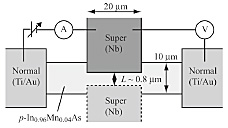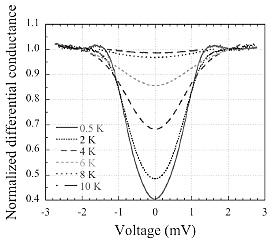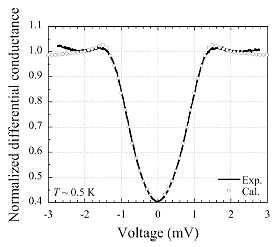Hiro Munekata2, and Hideaki Takayanagi4,5
1Physical Science Laboratory, 2Tokyo Inst. Tech., 3Nagoya Univ.,
4Tokyo Univ. of Science, 5NIMS-MANA
In superconductor/ferromagnet (S-F) junctions, new quantum phenomena can
be expected from the interplay between the superconductivity and the spin
polarization of the ferromagnet. This interplay allows us to determine
experimentally the spin polarization of carriers P in a ferromagnet using Andreev reflection spectroscopy [1]. However, it
is inferred that, in an S-F junction, the pair potential Δ in a superconductor
is weakened as a result of the penetration of the exchange field from a
ferromagnet into a superconductor, which is called the inverse proximity
effect. This interesting deliberation has motivated us to study the influence
of the inverse proximity effect on spin-polarized carrier transport across
the S-F interface as well as the estimation of the P value.
We fabricated Nb/ferromagnetic semiconductor p-In0.96Mn0.04As junctions as shown in Fig. 1. Below 〜10 K, p-In0.96Mn0.04As becomes ferromagnetic, as evidenced by the hysteretic transverse resistance
caused by the anomalous Hall effect. Figure 2 shows the dI/dV-V characteristics of a Nb/p-In0.96Mn0.04As junction at various temperatures. Below the TC of Nb (〜8.2 K), a conductance reduction occurs within the bias voltage
that is comparable to the Nb superconducting energy gap. A rather moderate
slope in the differential conductance curves within the gap region indicates
the partial suppression of the Andreev reflection caused by spin-polarized
carriers in p-In0.96Mn0.04As. The P value in p-In0.96Mn0.04As has been extracted by fitting the measured differential conductance
curves with a newly modified Blonder-Tinkham-Klapwijk model [2] with both
spin polarization and the inverse proximity effect as shown in Fig. 3.
The extracted P value is P = 0.725 at 0.5 K, and it decreases gradually with increasing temperature.
This work was supported in part by the "Topological Quantum Phenomena"
KAKENHI on Innovative Areas from MEXT.
[1] R. J. Soulen Jr. et al., Science 282 (1998) 85.
[2] G. E. Blonder et al., Phys. Rev. B 25 (1982) 4515.
 |
||
|
 |
 |
|||||
|
|